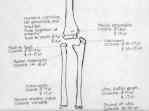- Discussion:
- OCD is a localized fragmentation of the bone and overlying cartilage of the capitellum;
- it frequently progresses to loose body formation, and sometimes progresses to posttraumatic arthritis;
- laxity of the MCL may accentuate the loading on the capitellum;
- osteochondritis dissecans of the capitellum tends to occur in patients 10-16 years of age;
- it is commonly found in young (10 yr old) baseball pitchers;
- during the acceleration phase, the elbow assumes a valgus position which loads the capitellum; (see: Injuries of the Throwing Elbow)
- it should be distinguished from Panner's Disease:
- Clinical Findings:
- poorly localized lateral elbow pain, w/ catching and locking;
- swelling and flexion contractures are common;
- MCL may show laxity;
- palpate the entire capitellum by flexing and extending the elbow;
- Radiographs:
- see radiology of pediatric elbow
- localized area in capetellum w/ rareification and crater formation;
- in some cases, typical AP radiograph will be normal, but an AP with the elbow in 45 deg of flexion will show irregularities, flattening
and/or fragmentation c/w OCD;
- MRI and CT-arthrogram: may be helpful in some cases:
- on MRI, early osteochondritis dissecans will show a discrete area of low signal intensity on T1 images;
- early on, T2 images may show no abnormalities;
- Treatment: based on degree of degree of lesion displacement;
- non-displaced lesions:
- treated w/ rest and gentle ROM exercises
- throwing activities are strictly not allowed until symptoms subside and full range of motion is restored;
- displaced lesions:
- if reduction of activities and physical therapy do not improve symptoms, then arthroscopic debridement should be considered;
- specific indications for arthroscopy include: frequent locking, persistent flexion contracture, pain, despite participating in physical therapy;
- theoretically would benefit from arthroscopic pinning or fragment excision
Osteochondritis dissecans of the elbow. A long-term follow-up study.
The Surgical Treatment of Osteochondritis of the Capitellum.

